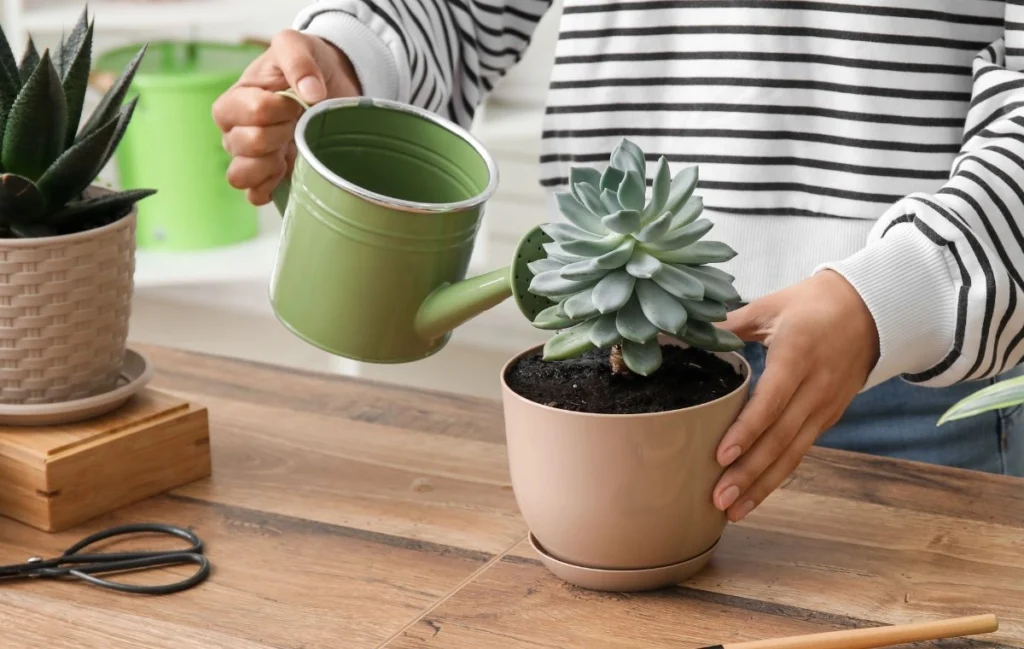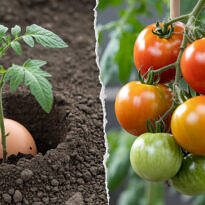Have you ever wondered why your succulents, those adorable chubby little plants, sometimes seem so sad and wilted, even with all the care in the world?
Ah, succulents! With their exotic shapes, vibrant colors, and an apparent promise of “easy care,” they have invaded our hearts and gardens, promising a touch of green without the drama of more demanding plants. But then, why do so many of us end up facing pots of succulents that seem to go from bad to worse? Could it be that we really have a “brown thumb”?
Could the answer lie in the way we water them? Is there a mystical secret behind the perfect watering of these plants? Or maybe, just maybe, we’ve been doing it wrong all along, turning our Midas touch into a… well, let’s just say, a not-so-golden touch.

And how can we become masters in the art of watering succulents, ensuring that our plants not only survive but thrive, bloom, and spread joy throughout our spaces with the minimum possible drama?
In this article, we will unveil the 7 Secrets of Watering Succulents, essential for keeping your plants healthy, growing, and multiplying. Get ready to dive into the fascinating world of succulents, where proper watering can make all the difference between a plump and vibrant plant and a succulent that is droopy, colorless, and seems to not move forward. Let’s turn those sad succulent pots into true lush and happy sculptures!
Before we dive into our secrets, let’s debunk some myths on the topic. Ah, yes! The gardening world is full of myths and half-truths, especially when it comes to succulents. These plants, despite their robust and uncomplicated appearances, are surrounded by a mystique that can confuse even the most dedicated gardeners. We will debunk three of the most common myths about watering succulents and clarify what really makes these chubby beauties thrive.
Myth 1: “Succulents Don’t Like Water”
This is a classic! Despite being associated with arid environments and an impressive ability to store water, saying that succulents “don’t like water” is a big misunderstanding. In fact, they enjoy a good watering – but with a significant caveat. The key is not in the amount of water, but in the frequency. Succulents like a good soak followed by a drying period, simulating the sporadic rain cycle of their natural habitats. So, while they definitely need water to survive, continuous excess is the real villain here. Failing to water your plants can slowly diminish them and prevent them from reaching their full potential.
Myth 2: “Succulents Prefer to Be Watered Little by Little”
Another common misconception is the idea that when watering succulents, we should use just a little bit of water at a time. Some people even use droppers or syringes! This method can lead to an underdeveloped root system, as the roots have no incentive to grow in search of water. The ideal is to water deeply, ensuring that the water reaches the bottom of the pot, moistens the entire substrate, and then allows the soil to completely dry before the next watering. This encourages the roots to grow strong and healthy, giving the plant a better foundation to absorb nutrients and remain stable. Additionally, this deep watering is crucial for removing the build-up of salts that naturally occurs in our pots, as we will see later.

Myth 3: “In the Heat, Water Your Succulents More”
The logic seems solid at first glance: more heat, more evaporation, more thirst, right? Well, it’s not so simple with succulents. Although it’s true that summer may require a slightly higher frequency of watering due to evaporation, it’s crucial to resist the temptation to overwater. Succulents are adapted to withstand heat and drought, storing water in their leaves to survive periods without rain. Among these adaptation mechanisms is also the almost complete halt of photosynthesis and respiration when the heat is too intense.
During these times, water can do more harm than good. A plant that is not actively metabolizing is an easy target for pests and diseases. Increasing the frequency or amount of watering during the hot months can, paradoxically, lead to root rot and other moisture-related problems. But beware! This rule only applies to those succulents that take a break at the height of summer, not to all. If your plant is growing and blooming like never before, do not reduce watering.
Now, by debunking these myths and understanding how plants work, we can get closer to the ideal in caring for our succulents, ensuring they receive exactly what they need to not only survive but also to thrive. Remember, understanding the unique needs of your succulent plants is the first step to cultivating an indoor or outdoor garden full of life, color, and, of course, succulence!
1. Forget Soaking Watering:
Many succulent enthusiasts initially see soaking watering as a foolproof method to ensure their plants get enough water. However, this widely shared technique by YouTubers and influencers may not be the paradise it seems. Besides being impractical, laborious, and messy, soaking can destabilize the delicate balance of the substrate, disturbing the structure that supports the plant’s roots. This disturbance can make your succulents more vulnerable to diseases and stress.
Moreover, soaking opens the door for the spread of pests, such as nematodes and root mealybugs, among your plants. These common parasites among succulents can easily travel through water, infesting other succulents sharing the same bath. Therefore, although it may seem counterintuitive, avoiding soaking can actually protect your succulents from long-term health issues, keeping the environment around the roots more controlled and safe.
Understand that soaking is not all bad. Reserve soaking for those times when you need to save a plant that is severely dehydrated. This is uncommon for succulents but can happen to indoor plants after a prolonged trip, for example.
2. Water Deeply:
The concept of deep watering goes beyond simply providing water to your plants. This method encourages roots to grow strong and deep, creating a solid foundation for the plant’s overall health. When water is applied superficially, roots tend to stay on the surface, or even just run down the side of the pot, making plants more vulnerable to periods of drought and water stress. Watering deeply, until water runs out of the bottom of the pot, ensures that all parts of the substrate are adequately moistened, promoting a robust and well-distributed root system.
This method also helps flush out excess minerals from the soil, which can accumulate due to the evaporation of surface water and prolonged use of fertilizers. Removing these salts prevents toxicity that can harm the roots and affect plant growth. Therefore, while it may require a bit more patience and attention, deep watering is an investment in the longevity and vigor of your succulents.

3. Patience Between Waterings:
Patience is a virtue, especially when it comes to caring for succulents. These plants have adapted to survive in conditions where water is scarce, developing the ability to store water in their leaves, stems, or roots. Watering them before they have had a chance to use up this reserve can lead to problems such as root rot, one of the biggest dangers to the health of succulents.
Developing a method to check the substrate’s moisture is crucial. And you can choose your own way. This can be done in several ways: feel the weight of the pot (a light pot indicates dry soil), insert a finger or a stick into the substrate to assess moisture below the surface, or even use a moisture meter. These techniques help ensure that you only water your succulents when truly necessary.
Moreover, understanding the unique rhythm of your succulents and adapting watering to their specific needs, rather than following a rigid schedule, can make all the difference. This means observing not just the soil, but also the signs the plant itself gives, such as the slight wilting of leaves or the texture of the surface, indicating it’s time for more water. By adopting this patient and observant approach, you create an environment where your succulents can not just survive but truly thrive.
4. Forget the Saucer Under the Pot
Saucers under pots may seem like a convenient solution to protect furniture and flooring from runoff water, but this practice carries a significant risk to the health of your succulents. Water accumulated in saucers creates a constantly moist environment around the base of the pot, which can be an open invitation to issues such as bacterial and fungal infections, leading to the dreaded root rot. And we’re not even talking about extremes like pooled water and breeding grounds for dengue mosquito and other harmful insects, because if it reaches a point like that, really, succulents stand no chance.
To avoid these problems, remove the saucers or empty them immediately after watering. If you need to protect your surfaces, consider watering your plants over the sink or in a basin and then moving them back to their usual spot. In the garden or nurseries, use bases with feet or supports that elevate the pot, like slats, allowing air to circulate freely and any excess water to drain without being retained. This keeps the bottom of the pot dry and promotes a healthy environment for the roots. Pots with adequate drainage are essential; therefore, if possible, choose pots that have enough holes to allow the excess water to flow freely. Pots without holes should only be used for temporary arrangements, with extra care in watering to avoid soil saturation and thus prolong their lifespan.

5. The Secret is in the Potting Mix
Perfect watering is useless if the potting mix is not good. The choice of potting mix is a crucial factor in the successful cultivation of succulents. An unsuitable potting mix, which retains too much moisture or compacts easily, can suffocate the roots and prevent them from breathing, leading to serious health problems, such as root rot. The ideal potting mix for succulents should be porous, airy, and drain well, allowing water and air to flow freely.
To create an ideal environment for your succulents, look for specific cactus and succulent potting mixes or make your own mix using components like perlite, coarse sand, fine gravel, and peat. The addition of common soil or organic material should be minimized, as it retains moisture. Moreover, incorporating elements like pumice stone or vermiculite can improve aeration and facilitate drainage. Avoid ready-made recipes taught out there. Adapt the recipe to your reality. If in your location it’s hot and water evaporates quickly, maybe more organic matter and even some garden soil are needed. In places where water takes longer to dissipate, more draining and airy mixes are necessary.
Over time, even the best potting mix will compact. Therefore, incorporating periodic replanting into your succulents’ calendar is important. Replanting is also an opportunity to check the health of the roots and replace old substrate, keeping it fresh, airy, and nutritious. This not only revitalizes your plant but also allows adjusting the composition of the potting mix as you observe what works best for your specific cultivation conditions. Remember, a good potting mix is the basis for the long-term health of your succulents, providing the perfect balance between water retention and drainage to promote healthy and vigorous growth.

6. Observe Your Plants
One of the greatest joys and, at the same time, challenges of caring for succulents is learning to “listen” to what they are trying to tell us. Do not go about things on autopilot. Succulents, though they cannot speak, communicate their needs and discomforts through their colors, shapes, and textures. Closely observing your plants can reveal a lot about what they need to thrive.
For example, wilted or wrinkled leaves often indicate dehydration, suggesting that it might be time to water. On the other hand, softened or translucent leaves can be a sign of overwatering. The color of the leaves also offers clues: leaves turning pale or yellowish may be receiving too much or too little sunlight, while vibrant and rich colors usually indicate a healthy plant.
Additionally, succulents enter periods of dormancy, during which their growth slows down or stops completely. These periods can vary depending on the species and climate. Some enter dormancy in winter, while others in summer. During dormancy, succulents require less water. Adjusting your watering routine to accommodate these seasonal changes is crucial to avoid common problems like root rot.
7. Discover the Specifics of the Species
Imagine arriving at a hotel where you made a reservation, and being greeted by your name, with your personal preferences attended to and remembered. You would feel pampered and happy with such care in service, wouldn’t you? The same goes for succulents.
Treating all succulents the same is a common mistake among beginner gardeners. Each succulent species has its own specific needs and preferences, which can vary significantly. For example, while some succulents thrive under direct sunlight, others prefer partial shade. Moreover, while most succulents prefer a period of drought between waterings, some species, especially those that are epiphytes, may need a bit more moisture.
Knowing the name and natural habitat of your succulent can provide valuable clues on how to care for it. For example, succulents that are native to desert areas of Mexico generally prefer full sun and well-drained soil, while those from tropical forests or the mountainous climate of the Andes may tolerate more humid conditions and less sunlight.
Furthermore, some types of succulents have specific nutritional needs. Knowledge about the soil pH preference, whether the plant likes more acidic soil, or if it is one of the rare succulents that appreciate calcareous soils, or if it has a higher demand for certain nutrients like magnesium, can help customize care for each plant. It’s also worth noting water preferences – some succulents may prefer rainwater, which is naturally soft and slightly acidic, while others adapt better to hard well water, rich in minerals.

By taking the time to understand the specifics of the succulents you have at home, you not only increase your chances of successful cultivation but also develop a deeper and more rewarding connection with your plants. This detailed knowledge allows you to provide the exact care your succulents need, ensuring they not only survive but flourish under your care.
Concluding our journey through the secrets of watering succulents reminds us of an undeniable truth: even the most resilient and uncomplicated plants like succulents need a bit of love, attention, and, of course, the right amount of water. But who would have thought that to keep these beautiful green creatures happy, we would have to learn the art of patience, observation, and balance? After all, it’s not every day that one discovers that a simple act of watering can be so complex and, at the same time, so fascinating.
Caring for succulents does not have to be a dry and lifeless task. With the secrets revealed above, you are more than prepared to dive into the succulent world with confidence, knowing that the survival of your little plants is in good hands (or perhaps, in good waterings!).
Now is the time to get your hands in the soil (or the appropriate potting mix) and explore! I invite you to become the master of watering your succulents. Experiment, observe, adjust, and above all, have fun. Share your discoveries, successes, and even the aquatic slips, because, in the end, every drop counts on your journey, and even the most experienced gardeners make mistakes.
So, how about grabbing that watering can, giving a smile, and showing your succulents how much love and water they deserve?







